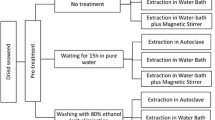Abstract
Six economically important species ofGracilaria, from a number of commercial sources around the world, andGracilariopsis lemaneiformis, collected from two Japanese localities, were used as the sources of raw material for the evaluation of agar quality. Agar-agar was extracted by pretreatment with various concentratrions of NaOH (0%, 3%, 5%, 7%, 10%) incubated at 80 °C for 2 h. Agar yield, viscosity, dynamic gelling and melting temperature and gel texture were determined for 1.5% agar gels. The highest agar yield was obtained fromG. gracilis from Argentina (39.5%), while the lowest was from BrazilianG. gracilis (13.37%). Dynamic gelling temperature was highest in the agar fromG. gracilis from Turkey (59 °C) and lowest in the non-alkali treated agar isolated fromG. edulis from Indonesia (46 °C). Melting temperature ranged from 96 °C in the agars from the JapaneseGracilariopsis andG. chilensis from Chile to 69 °C in the non-alkali treated agar fromG. edulis from Indonesia. In general, all species produced an agar with high gel strength after treatment with 5% NaOH, except forG. chilensis and the twoGracilariopsis species, which produced an agar with high gel strength after treatment with 3, 7 and 10% NaOH. The highest gel strength (2056 ± 13.6 cm−2) and hardest gel (261 ± 19.89 g mm−2) were obtained fromG. lemaneiformis from Japan (Oita Prefecture) after treatment with 7 and 10% NaOH respectively. The lowest gel strength (351 ± 93 cm−2) was obtained fromG. gracilis from Brazil after treatment with 3% NaOH. The softest gel (66.31 ± 9.63 g mm−2) was isolated fromG. tenuistipitata from China, after treatment with 3% NaOH. The most flexible gel (11.62 ± 0.31 g mm−2 × 102) was obtained fromG. chilensis from Chile after treatment with 3% NaOH.
Similar content being viewed by others
References
Armisen R (1995) World-wide use and importance ofGracilaria. J. appl. Phycol. 7: 231–243.
Chirapart A, Katou Y, Ukeda H, Sawamura M, Kusunose H (1995) Physical and chemical properties of agar from a new member ofGracilaria, G. lemaneiformis (Gracilariales, Rhodophyta) in Japan. Fish. Sci. 61: 450–454.
Duckworth M, Yaphe W (1971) The structure of agar. Part II. The use of a bacterial agarose to elucidate structural features of the charged polysaccharides in agar. Carbohyd. Res. 16: 435–445.
Hayashi K, Okasaki A (1970) Handbook on Agar. Korinshoin, Tokyo. 543 pp (in Japanese).
Hurtado-Ponce AQ, Umezaki I (1988) Physical properties of agar gel fromGracilaria (Rhodophyta) of the Philippines. Bot. mar. 31: 171–174.
Hurtado-Ponce AQ (1992) Rheological properties of agar fromGracilariopsis heteroclada (Zhang et Xia) Zhang et Xia (Gracilariales, Rhodophyaa) treated with powdered commercial lime and aqueous alkaline solution. Bot. mar. 35: 365–369.
Kim DH (1970) Economically important seaweeds in Chile. I.Gracilaria. Bot. mar. 13: 140–162.
Murano E (1995) Chemical structure and quality of agars fromGracilaria. J. appl. Phycol. 7: 245–254.
Nishinari K, Watase M (1983) Effect of alkali treatment on the rheological peoperties of concentrated agar-agar gels. Carbohyd. Polymers. 3: 39–52.
Yaphe W, Duckworth M (1972) The relationship between structures and biological properties of agar. Int. Seaweed Symp. 7: 15–22.
Author information
Authors and Affiliations
Additional information
Author for correspondence
Rights and permissions
About this article
Cite this article
Rebello, J., Ohno, M., Ukeda, H. et al. Agar quality of commercial agarophytes from different geographical origins: 1. Physical and rheological properties. J Appl Phycol 8, 517–521 (1996). https://doi.org/10.1007/BF02186330
Received:
Accepted:
Issue Date:
DOI: https://doi.org/10.1007/BF02186330




